Carex arcta (Northern Clustered Sedge)
| Also known as: | |
|---|---|
| Genus: | Carex |
| Family: | Cyperaceae (Sedge) |
| Life cycle: | perennial |
| Origin: | native |
| Habitat: | part shade, shade, sun; moist to wet; floodplains, swampy woods, shores, stream and river banks |
| Fruiting season: | June - August |
| Plant height: | 6 to 30 inches |
| Wetland Indicator Status: | GP: none MW: OBL NCNE: OBL |
| MN county distribution (click map to enlarge): |  |
| National distribution (click map to enlarge): |  |
Pick an image for a larger view. See the glossary for icon descriptions.
Detailed Information
Spikes: 

![[photo of spike clusters]](/udata/r9ndp23q/grass/carex-arcta_0725_154731-t.jpg) 5 to 15 oblong-elliptic spikes, each up to 1 cm (3/8 inch) long, usually all crowded near the tip though the lowest spikes may be slightly separated. All spikes have a few staminate (male) flowers at the base and pistillate (female) flowers at the tip (gynecandrous).
5 to 15 oblong-elliptic spikes, each up to 1 cm (3/8 inch) long, usually all crowded near the tip though the lowest spikes may be slightly separated. All spikes have a few staminate (male) flowers at the base and pistillate (female) flowers at the tip (gynecandrous).
![[photo of lowest bract]](/udata/r9ndp23q/pd3/carex-arcta-0715166-8-t.jpg) At the base of the lowest 1 or 2 spikes is a broad, scale-like bract with a green midrib that extends to a bristle-like tip that is usually longer than the spike but does not usually overtop the terminal spike. Bracts on the upper spikes are scale-like and inconspicuous.
At the base of the lowest 1 or 2 spikes is a broad, scale-like bract with a green midrib that extends to a bristle-like tip that is usually longer than the spike but does not usually overtop the terminal spike. Bracts on the upper spikes are scale-like and inconspicuous.
Leaves and stems: 


![[photo of sheath and ligule]](/udata/r9ndp23q/grass/carex-arcta_0725_154909-t.jpg) Leaves are basal and alternate, mostly near the base, 2 to 4 mm wide, up to 15 inches long, longer or shorter than the flowering stems, mostly floppy. Stem leaf sheaths are thin, translucent whitish, concave at the tip, the lower sheaths loosely wrapping the stem and the upper usually more snug. The lowest sheaths are minutely dotted reddish or purple. The ligule (membrane where the leaf joins the sheath) is as long as or longer than wide. Leaves are hairless and flat, though V-shaped in cross-section when young and may be rough along the edges, especially near the tip.
Leaves are basal and alternate, mostly near the base, 2 to 4 mm wide, up to 15 inches long, longer or shorter than the flowering stems, mostly floppy. Stem leaf sheaths are thin, translucent whitish, concave at the tip, the lower sheaths loosely wrapping the stem and the upper usually more snug. The lowest sheaths are minutely dotted reddish or purple. The ligule (membrane where the leaf joins the sheath) is as long as or longer than wide. Leaves are hairless and flat, though V-shaped in cross-section when young and may be rough along the edges, especially near the tip.
![[photo of plant base]](/udata/r9ndp23q/grass/carex-arcta_0704_122517-t.jpg) Bases are wrapped in a brown sheath that may become fibrous, and the remains of the previous season's leaves typically persist around the base. Stems are slender, 3-sided, rough along the angles, mostly erect, and some elongating up to 30 inches at maturity. Not all plants produce flowering stems. Plants form loose to dense clumps from short rhizomes.
Bases are wrapped in a brown sheath that may become fibrous, and the remains of the previous season's leaves typically persist around the base. Stems are slender, 3-sided, rough along the angles, mostly erect, and some elongating up to 30 inches at maturity. Not all plants produce flowering stems. Plants form loose to dense clumps from short rhizomes.
Fruit: 
![[close-up of maturing spike]](/udata/r9ndp23q/grass/carex-arcta-080417-s2-t.jpg) Fruit develops in early through mid-summer, the pistillate spikes forming clusters of seeds (achenes), each wrapped in a casing (perigynium), subtended by a scale. Pistillate spikes each contain 10 to 20 fruits that are spreading to ascending and tightly crowded on the stalk.
Fruit develops in early through mid-summer, the pistillate spikes forming clusters of seeds (achenes), each wrapped in a casing (perigynium), subtended by a scale. Pistillate spikes each contain 10 to 20 fruits that are spreading to ascending and tightly crowded on the stalk.
![[photo of perigynia front and back, scales and achene]](/udata/r9ndp23q/grass/carex-arcta-070817-s6-t.jpg) Pistillate scales
are generally egg-shaped, translucent white with a green midrib, later tinged brown, blunt to pointed at the tip, and half to nearly as long as the perigynia.
Perigynia
are 2 to 3 mm long, 1.1 to 1.5 mm wide, light green to yellowish brown at maturity, distinctly 4 to 7-veined on the front, veinless or obscurely veined on the back, hairless, tightly wrapping the achene but spongy at the base, the body egg-shaped, widest near the base, a short taper to the beak with minute teeth along the edge, 2 teeth at the tip of the beak.
Achenes
are 1.25 to 1.5 mm long, about 1 mm wide, flattened lens-shaped, and mature to light brown.
Pistillate scales
are generally egg-shaped, translucent white with a green midrib, later tinged brown, blunt to pointed at the tip, and half to nearly as long as the perigynia.
Perigynia
are 2 to 3 mm long, 1.1 to 1.5 mm wide, light green to yellowish brown at maturity, distinctly 4 to 7-veined on the front, veinless or obscurely veined on the back, hairless, tightly wrapping the achene but spongy at the base, the body egg-shaped, widest near the base, a short taper to the beak with minute teeth along the edge, 2 teeth at the tip of the beak.
Achenes
are 1.25 to 1.5 mm long, about 1 mm wide, flattened lens-shaped, and mature to light brown.
Notes:
Carex arcta is an occasional sedge found in north-central and northeastern Minnesota, primarily in seasonally or temporarily wet places, such as floodplains, borders of ponds and lakes, and woodland swales. We encountered it in the wooded backwaters of the Kettle River in Pine County and in Lake County near the shore of a small lake subject to spring flooding. In other parts of its range it may be found in wet meadows, marshes and bogs.
Carex is a large genus, with over 600 species in North America and 150+ in Minnesota alone. They are grouped into sections, the species in each group having common traits. Carex arcta is in the Glareosae section; some of its common traits are: typically clump forming, leaves V-shaped in cross-section when young, leaves hairless and 4mm or less wide, 2 to 10 stalkless spikes, spikes all essentially alike with staminate flowers at the base (gynecandrous), perigynia ascending to spreading and flattened in cross-section, beaked, the beak usually toothed, flattened lens-shaped achenes, typically growing in wetlands.
Carex arcta is distinguished by leaves to 4 mm wide that may be longer or shorter than the flowering stems, at least the lower sheaths loosely wrapping the stem and usually purple or red dotted, the lowest spike(s) have a scale-like bract with a long bristle-like tip, 5 to 15 spikes usually all crowded at the tip, spikes with 10 to 20 spreading to ascending perigynia, perigynia widest near the base, beaked and distinctly 4 to 7-veined on one side, and frequently found in seasonally or temporarily wet habitats (but not always). Regarding the purple-dotted sheaths: most references make much ado of this distinguishing characteristic but we did not readily observe this on our field specimens. However, dots were visible on dried herbarium specimens, on the lowest sheaths but not the upper. If we happen upon this species again we'll take another look to see how noticeable the dots really are on live specimens.
Native Plant Nurseries, Restoration and Landscaping Services ↓
More photos
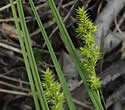 Carex arcta plant
Carex arcta plant Carex arcta plant
Carex arcta plant Carex arcta plants
Carex arcta plants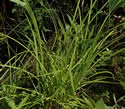 Carex arcta plants
Carex arcta plants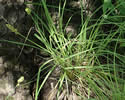 Carex arcta in swampy woods
Carex arcta in swampy woods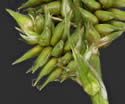 spikes tightly crowded
spikes tightly crowded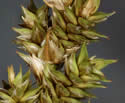 spikes less crowded
spikes less crowded
Photos by K. Chayka taken in Lake and Pine counties. Photos by Peter M. Dziuk taken in Lake County.
Comments
Have you seen this plant in Minnesota, or have any other comments about it?
on: 2019-06-11 18:09:52
In a sedge meadow-shrub carr.
on: 2022-08-10 16:02:50
I would like to know if it's invasive plant
on: 2022-08-10 16:57:17
Bill, see the national distribution map. This sedge is native to the US and Canada. I wouldn't consider it invasive in Manitoba or anywhere else in North America.






